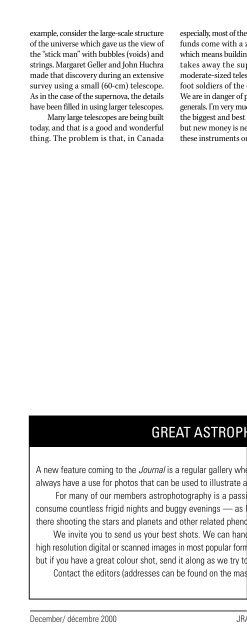I N S I D E T H I S I S S U E
insidethisissue - The Royal Astronomical Society of Canada
insidethisissue - The Royal Astronomical Society of Canada
- No tags were found...
You also want an ePaper? Increase the reach of your titles
YUMPU automatically turns print PDFs into web optimized ePapers that Google loves.
News NotesEn ManchettesWEATHER FORECASTS FORCANADIAN ASTRONOMERSA sample cloud forecast image for westernCanada from the CMC web site. The originalimage uses colours to represent the highestand lowest clouds so some information is lostwhen converted to black and white. Imagecourtesy of Allan Rahill and CMC.During a night of deep sky observing orhigh precision photometry a thin veil ofcirrus cloud can often spoil the sky andruin a night’s observing. Yet the weatherforecast may have predicted clear skiesfor that night. For most people the skywould be clear enough, but for astronomersit is a disaster.For years the public forecast maynot have been specific enough to predictthis kind of situation. Now, Allan Rahillof the Canadian Meteorological Centre(CMC) in Dorval, Quebec has developeda 48-hour web forecast specifically forastronomers (www.cmc.ec.gc.ca/cmc/htmls/astro_e.html). Rahill’s productis based on work done by Arne Alfheim,also from CMC. Alfheim used the outputfrom the Canadian regional meteorologicalforecasting model to produce a simulatedsatellite image of the cloud cover. Theimage is fashioned after the 10.70-micronchannel from the Geostationary OperationalEnvironmental Satellites (GOES-8 andGOES-10). In these simulated infraredimages the higher, and thus colder cloudsshow up as brighter areas, while darkerareas indicate lower and warmer clouds.An animation loop shows the motion ofthe forecasted cloud deck and helps revealthe movement of low cloud, which caneasily be mistaken for terrain, especiallyin the colder months.Rahill is not only a meteorologistbut is also an avid amateur astronomerwith a robotic 0.56 metre Newtonian and30 years of observing experience, so heknows what astronomers want out oftheir weather forecasts. Eventually, hewould like to include actual transparencyand seeing values.These cloud cover forecasts comewith the same caveat as the regularforecasts. Since meteorologists can neverobtain perfect knowledge of the currentstate of the atmosphere, the forecastscan never be 100-percent accurate. Thefurther into the future the forecast looks,the less certain it becomes. Nonetheless,this new product should improveastronomers’ chances of finding clearskies.WHERE ARE EARTH’S TROJANS?How do you look for asteroids in Trojanorbits with the Earth? Well, for one thing,don’t look exactly in the place where youmight expect them to be. So writes Dr.Paul Wiegert, of the Department of Physicsand Astronomy at York University, andco-workers in a recent article publishedin the journal Icarus.Trojan asteroids occupy specialorbits. Their extraordinary nature stemsfrom the fact that they orbit the Sun atthe same distance as one of the planets,but they always remain either 60 degreesahead of, or behind, a line drawn betweenthe planet and the Sun. Joseph LouisLagrange first demonstrated the existenceof these special orbits, in which the asteroidremains stationary in the reference framerotating with the planet, in 1772. Indeed,Lagrange was able to show that withinthe so-called three-body gravitationalproblem five stable points should existin the reference frame rotating with theplanet. The Trojan orbits correspond toasteroids orbiting the Sun at the LagrangeL4 and L5 points, and they fall at theapexes of two equilateral triangles drawneither side of the planet–Sun line.The first Trojan object, asteroid 588Achilles, was discovered in 1906, and itresides at the L4 point of the Jupiter–Sunsystem. At the latest count, Jupiter hassome 466 Trojan companions, and theplanet Mars has two. In principle theEarth may have an accompanying troopof Trojan objects, but to date none havebeen discovered. This may be, as PaulWeigert, Kimmo Innanen and SeppoMikkola point out in their recentpublication, because the best searchstrategy for finding Earth Trojans is notnecessarily the one that simply monitorsthe region of the sky containing Earth’sL4 and L5 points.Weigert and co-workers highlighttwo important points in their study. Firstly,asteroids near the L4 and L5 points can,in fact, move on “tadpole-like” orbits,which enables them to temporarily moveahead of and behind the stable positions.This effect alone can widen the sky searcharea by several tens of degrees on eitherside of the Lagrange points. In addition,the brightness of an asteroid is not onlyrelated to its distance from Earth, butalso to its phase angle (the angle subtendedbetween the Earth, the asteroid, and theSun). By modeling both the brightnesseffect, and including “tadpole” orbits,Weigert et al. find that the best place tolook for, and detect, Earth Trojans arenot at the L4 and L5 points, but in regionsthat are displaced some five degrees closerto the Sun.After examining several hypothetical210JRASC December / décembre 2000
















